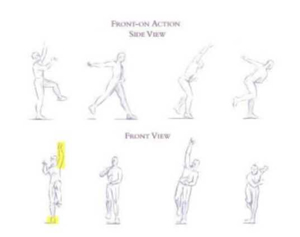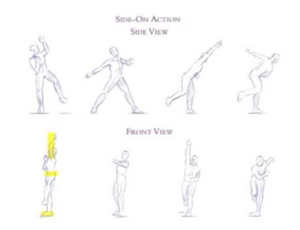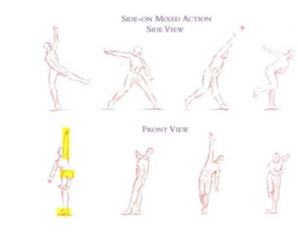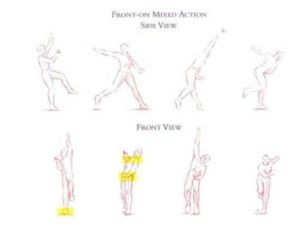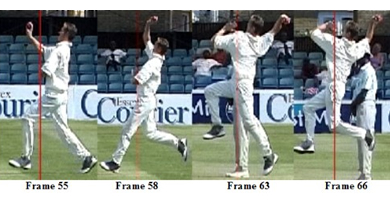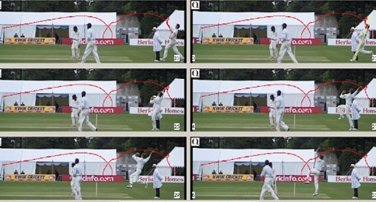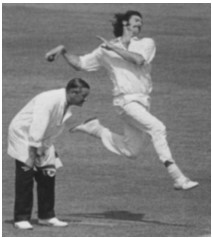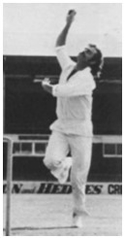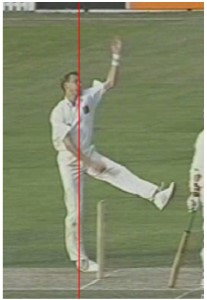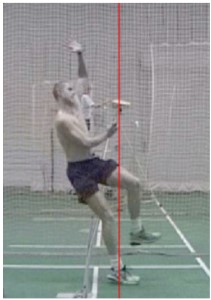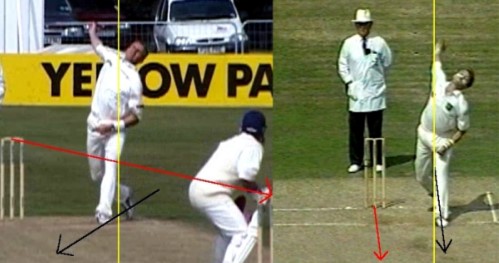|
Q4E Case Study 18 – Cricket Bowling
Proposed Subject usage: Sports Science A level & 1st/2nd yr Degree GCSE / A-level Sports Science – Cricket
Aim:
Injuries to Fast Bowlers are still unfortunately a very common occurrence. Over the years, sports biomechanical research into the fast bowling action has studied the relationships between technique, injury, physical preperation, equipment and even facilities… (For example: Foster et al., 1989; Elliott et al., 1993; Burnett et al., 1995; Bartlett et al., 1996; Burnett et al., 1998; Hurrion et al., 2000, Portus et al., 2000 and Portus et al., 2004). Sports Biomechanics has a number of roles to play within cricket bowling. Firstly, the legality of a bowling action, Secondly, Injury Prevention and Thirdly, the effecency and ‘Match Effectivness of the Bowling Action’. The problem of injury prevention & effecency is cruical for the longevity of a players career. The English and Wales Cricket Board advocates the use of Side-on and Front-on bowling techniques. |
Figure 1a: Front-on Action : Figure 1b Side-on Action
(Diagrams courtesy of ECB, Cricket Coaches Manual 2000)
A third style of bowling, often referred to as a semi-open or ‘Midway’ action is also as advocated by the English and Wales Cricket Board as a safe bowling technique. This type of bowling action is essentially a cross between the Side-on and Front-on bowling actions. If a young bowler can’t get their feet totally side-on at Back Foot Contact (BFC), or find it difficult to bowl side-on then they should be encouraged to bowl with a more open-chested action (45 degrees) or ‘midway’ action. It is important however that the shoulders match the position of the hips (45 degrees) at BFC (Bartlett et al., 1996).
The ‘Mixed’ bowling actions are still common amongst bowlers of all ages and has been shown to be a predominant factor related to injury; (Elliott et al., 1993, Bartlett et al., 1996, Portus et al., 2004 ). With the mixed bowling technique, the hip-to-shoulder miss-alignment occurs at BFC. Figure 2a & b. There are two types of mixed bowling technique, both of which have a hip-shoulder separation angle equal to or greater than 20 degrees at BFC (Hurrion 1997). The mixed bowling technique also requires the spine to adopt a twisted and hyper-extended position during front foot foot contact.
Figure 2a: Side-on Mixed Action – The shoulders are more front-on than the hips at BFC
Figure 2b: Front-on Mixed Action – The hips are more front-on than the shoulders at BFC
(Diagrams courtesy of ECB, Cricket Coaches Manual 2000)
Method:
During the summer of 2001, sixty fast-medium bowlers (mean age 15.2 ± 2.7 years) playing England age groups U13, U14, U15, U17 and U19 were filmed and analysed during competitive play. Each bowler was filmed from three angles, side-on, front-on and back view. Technical and biomechanical analysis were made for each bowler for each phase. These are described below and an example is shown in Figure 3.
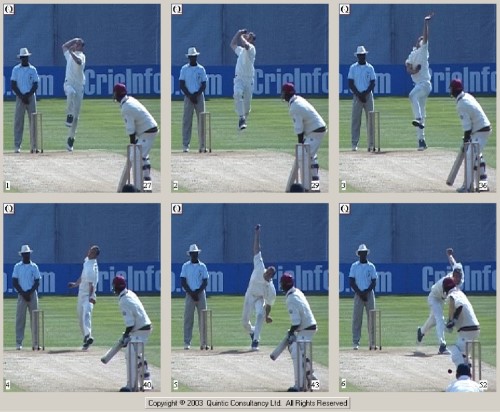
Figure 3
Phase 1: Pre Delivery Stride (PDS)
Phase 2: Mid bound (MB)
Phase 3: Back Foot Contact (BFC)
Phase 4: Front Foot Contact (FFC)
Phase 5: Ball Release (BR)
Phase 6: Follow Through (FT)
Throughout the bowling action the following key biomechanical parameters formed the bases of the study: approach speed, angle of run-up, feet position during the delivery phase, hip-to-shoulder separation angle, upper torso & arm position, release height, front knee angle during front foot contact, delivery stride length and follow through.
Data Acquisition and Analysis:
The bowling action was filmed using a standard digital video Sony TRV 900E camcorder. The camcorder was placed, face-on, rear view and side-on at 90 to the path of the action. The analysis was performed for the sixty fast-medium bowlers during match conditions. Digital video film (50Hz) was recorded for each of the three views for each bowler. After processing, the film was analysed using a Sony VAIO PCG-GRX316MP personal computer running Quintic Biomechanics 9.03 video analysis software. Two-dimensional scaling, prior to digitisation was carried out using two-dimensional calibration.
Coaches Analysing Sequence :
The seven most common technical problems are reported below. The percentage figure (in brackets) represents the number of bowlers associated with that particular technical problem. The technical problems presented in this document are, in the opinion of the author, the priority sequence that a coach should use as a template, when working with young fast bowlers: All the following descriptions assume a right-handed bowler bowling to a right-handed batsman.
1) Approach Speed: (Too Fast for optimum efficiency! – 85%)
In the majority of case all the sixty bowlers analysed had an athletic run-up. However, in a number of cases the basic gait (running style) would need to be corrected first prior to any technical intervention.
Approach velocity is a key component in the production of force. The quicker a bowler runs into the wicket, the greater the forces exhibited during both back foot and front foot contacts. The faster the bowler runs into the wicket, the greater their physical conditioning needs to be to withstand the ground reaction forces (GRFs), in particularly at front foot contact. This can be anywhere between five to ten times the body weight (BW) of the bowler for each delivery (Bartlett et al. 1996; Hurrion et al. 2000).
Eighty five percent of the bowlers analysed in this study had an approach velocity that the author would consider too fast for them to deliver the cricket ball efficiently. There is an optimum approach speed for each bowler that enables him or her to deliver the ball in a controlled and efficient manner. This is hugely dependent on the strength and conditioning of the bowler. It was noted that none of the bowlers ran in too slowly! The basis for determining what constitutes too fast a run-up speed was based on the ability of the bowler to achieve a controlled release position. A controlled release position was catorgorised by a braced front leg (no decreasing of the front-knee angle / less than 5 degrees) and no lateral flexion at release. A controlled release position is independent of the type of bowler (front-on / side-on / midway). The approach velocity (linear speed of right hip joint centre at back foot contact BFC) was 5.02 m/s ± 0.21 m/s. The range of the approach velocities was 4.04 m/s to 6.26m/s. However, the majority of the bowlers created their speed in the early part of the run-up, with a considerable slowing down as the bowler approaches the wicket. This could be a function of run-up length. It was noted that front-on bowlers had a faster approach speed than the side-on bowlers.
The author wishes to remind the reader that the mean age of the bowlers in this study were 15.2 ± 2.7 years. There have been many fast bowlers who have been measured using even faster run-up speeds, than those reported in this study (Lillee, Akram, Roberts, Donald) and have yet bowled with straighter / braced front legs, however the strength and conditioning and physical maturity of such bowlers is significantly greater than those analysed in this study.
In coaching terms, there is such a thing as a bowler running in too fast, this may well contribute to a collapsing back or front knee during the action. However, it should also be pointed out that some very slow bowlers, and even wrist spinners with slower run-ups do not bowl over a braced front leg. This is still a grey area and subjective, with many scientists and biomechanist not fully agreeing on the correlation between of the run-up velocity and a controlled release position at ball release.
2) Lean Back – long arms prior to delivery encourages the torso to lean away from the target : Force Alignment directed upwards and not towards the target! – 40%)
For forty percent of the bowlers analysed the following symptom was very common: “What goes up must come down!” The higher and/or longer the bound becomes, the greater the force that is exerted on the body during BFC. This is generally caused by the bowling arm beginning to rise high above the bowler’s head – thus encouraging the ball and arm to move backwards whilst the body moves forwards. Run-up speed also has a key factor in the height and distance covered in the pre-delivery stride.
If the torso leans too far backwards prior to the take off for the delivery stride and the bowling action becomes long and slow. Frame 55 highlights the torso already starting to lean backwards, as the bowling arm starts to go up and away from the body. This occurs prior to the left foot making contact with the ground. At pre delivery-take-off, the ball is still behind the bowler (Frame 63). This causes the momentum of the bowler to go upwards and not towards the wicket and target (Video 1: Frames 64 to 68). There is a loss in horizontal speed in the bowling action at this point. Side-on bowlers are more prone to this problem, since they need more time than a front-on bowler in their pre-delivery stride to attain their side-on position. The unnecessary height of the bound (Frame 68) coupled with the loss in horizontal momentum has created a pre delivery stride that is too long (Frame 63 – 74). In some cases bowlers were covering over 3 meters in distance with their pre-delivery stride. This creates undue stress on the body during back foot landing. If this is happening to the lower half of the body, then the arms must be correspondingly long and slow. As a coach this is an important consideration, as if you modify the leg action you MUST then modify the arm movement. Ideally the arms in this phase should be more compact and held close to the body with the ball not rising above the eye level until back foot contact.
Figures 4 and 5
Figure 5 highlights the lean back in the torso along with the bowling arm going up and away from the body. This creates a small loop in the path of the bowling arm (Frame 3) in which the ball is actually traveling backwards – away from the target. A simple coaching point is to focus on the chest leading the way through the finishing line of a 100m line (break the tape), prior to pre-delivery take off. Many great fast bowlers including Dennis Lillee and Richard Hadlee have pulled the bowling arm up and back prior to delivery jump (see Figure 6a and 6b) however the torso in both positions is still very much upright. The actions of Lillee, Hadlee and others can be adopted, where the arm is going backward while the bowler is moving forward provided the amount of body lean back is controlled.
Figures 6a and 6b
3) Back Foot Collapse: (Unstable base! Loss of Momentum! – 25%)
There are three main reasons for the back knee collapsing prior to the delivery stride at Back Foot Contact (BFC).
1. The pre delivery stride is too long or too high. If it is exaggerated it may not only be inefficient and a waste of effort, but will heighten the risk of injury as the Ground Reaction Forces (GRF’s) at back and front foot contact will be increased. The higher and / or longer the bound becomes, the greater the force that is exerted on the body during BFC. Back foot forces are in the region of 2-3 times body weight (BW), similar to the GRF’s that occur during the run-up phase (Hurrion et al. 2000). There are different requirements for side-on and front-on bowlers. The height of the bound during the pre-delivery stride for a front-on bowler will not be as high as for a side-on bowler, who needs more time to rotate into position.
In the opinion of the author, a pre delivery stride that was too long or too high for the bowler was catorgorised by having a flexing right knee at Back Foot Contact (FFC) or more than 40º prior to extension of the right lower limb or had a knee angle of <140º. The mean ± S.E. was 46º ± 8º with a range of back foot flexion was between 6º and 108º. It was also noted that the greater the degree of right knee flexion, this resulted in an increase in delivery stride length, however this was not a significant correlation. Other factors such as angle of run-up, speed of approach even the athletes physical strength are key factors which influence the length of the delivery stride.
2. Run-up velocity (see point 1).
3. The angle of run up – several bowlers momentum was directed towards fine leg. At the moment of BFC the bowler then has to redirect his momentum towards the target. This takes time and effort! The more time spent on the back foot, the more energy is expended and the more momentum is lost through the crease. This also creates unnecessary stress on the hip and knee joint of the back leg. See Figure 6 for examples. The cause and effort result of a collapsing back leg is a long, slow and high movement of the front leg (See point 5 for details). Ideally, the bowler would want to get off the back foot as quickly as possible!
Many bowlers have performed very successfully with a curved run-up, including Malcolm Marshall and Merv Hughes, however the last four foot contacts, notablely Pre-Delivery, Back Foot Contact, Front Foot Contact, First Stride in the Follow Through were in a straight line: i.e. in the direction of the target. This is covered in more detail in section 7.
There was a significant correlation between those bowlers who had poor angle of run-up (Section 7) and those that had a greater degree of back knee flexion at BFC.
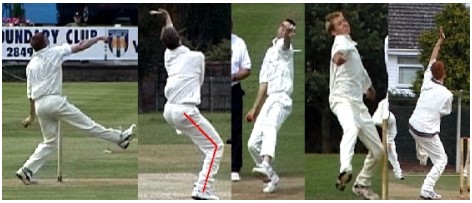
Figure 7
Note: From BFC until FFC the back knee has sunk lower and lower… The centre of mass has been lowered when the back knee flexes, this increases stability.
The longer you spend on your back foot – the longer the delivery stride becomes. The longer the delivery stride becomes – the harder it is to bowl over a braced front leg (A braced front leg is determined by having a constant knee angle during the release of the cricket ball). Increased stride length occurs when the back knee collapses thus the effective base of support area is increased as well during front foot contact, however stability does not always mean more power. The whole purpose of the run-up is to promote the body into dynamic instability at back foot contact – in coaching terms the quicker the bowler can get of the back foot the better…
Which bowler will spend the most time on their back foot; Figure 8a or Figure 8b?
Figures 8a and 8b
Answer: The bowler in Figure 8b – there is a huge braking force in this position, the bowler has to wait until his torso has moved in front of the back foot before he can begin to push forward. A lot of momentum is lost in this position, hence he will spend a long time on the back foot.
4) Blocking and Opening of the front foot: (Good stride alignment will reduce the chance of injury! – 65%)
One reason for bowlers blocking off the body with the front foot is the angle of run up. If this is combined with the collapsing back leg the bowler has a major problem. With this angled approach the bowler’s momentum is still directed towards fine leg. At the moment of BFC the bowler is unable to redirect his momentum towards the target and the front leg ends up going across body. This creates a tremendous amount of additional stress throughout the lower back. As a result the torso starts to fall away in order to allow the bowling arm to be redirected towards the target. In some cases a bowler started with their front leg aiming towards fine leg, however it is then realigned prior to front foot contact (FFC) more towards the direction of 1st or 2nd slip. This can lead to an excessive amount of lateral flexion – “falling away of the torso” prior to the release of the ball. (See point 6 for details)
Figure 9a and 9b gives an indication of the difference between good and poor alignment. The red arrow represents a straight line from the bowler’s middle stump to the target (batmen’s middle stump). The yellow line is a vertical line drawing. The black arrow indicates the direction of the feet at FFC. This example highlights the problems of blocking off the front foot during the delivery phase (Video 3a – Frame 24). It is very inefficient, plus it increases the amount of force around the lower back were injuries could occur very quickly. Figure 4a shows the black arrow pointing towards fine leg, where as in Figure 8b (Video 3b – Frame 29) the black arrow is pointing directly towards off stump. The front foot should line in alignment with the back foot at the target for optimal efficiency.
Figures 9a and 9b
5) Long Delivery Stride : (Collapsing / Flexing of the Front leg – 86%)
The role of the front leg during the FFC phase has been shown to influence ball speeds (Burden and Bartlett, 1990). This is as a result of an increase sequence of segmental movement and the ability to create a fixed pivot point from which to release the upper half of the body. However (Mason et al., 1989; Foster et al., 1989) have reported a link between the relationship of the front knee angle and lower back injury.
The criteria applied to the action of the front knee during the FFC phase – (Front foot contact to ball release) was as follows: (Note: n = number of bowlers) (Adapted from Hurrion 1997 & Portus et al., 2004);
Flexed Knee – Collapse at Knee: (n=54) Knee flexion of 10 degrees or more followed by less than 5 degrees of knee extension.
Flexed Knee – Extender: (n=2) Knee flexion by 10 degrees or more followed by more than 5 degrees of extension.
Extender – No Collapse (n=1): Knee flexion less than 10 degrees followed by knee extension by 10 degrees or more.
Straight Leg Technique – Constant brace (n=3): Both flexion and extension of the knee less than 5 degrees. Minimal amount of movement – Note: The naked eye would not see any movement at the knee joint.
All fast bowlers should flex their knee during the FFC phase. This will help reduce peak impact forces and increases the time to peak force by allowing the force to be attenuated over a longer time period. Impact forces at FFC can be in the region of 5 to 10 times body weight (BW) Hurrion 2000. Due to these high impact forces, the ideal front leg technique is one where the knee flexes at initial front foot contact (helping to absorb the initial impact force), followed by knee extension prior to ball release. This will enable an increase in delivery speed (Bartlett et al., 1996). However, only two bowlers analysed during this study were able to achieve this result. This front leg technique will enhance the muscular energy from all of the lower limb muscles, quadriceps, hamstrings, gleuts, pelvic and lower back muscles. Strength and conditioning is a must in these areas if a bowler is to perform this style of front leg technique. The ability to extend of the front leg will also increase the height of ball release for extra bounce and swing.
Fifty-four of the sixty bowlers had a front knee, which flexed more than 10 degrees during the delivery stride. This results in a loss of energy, plus reduce height at the point of release.
Fast bowlers with a history of back injuries should particularly avoid landing with a braced front leg because of the impact loads transmitted to the lower lumbar region (Portus et al., 2004). The braced front leg will increase the transmission of impact loads through the vertebral column, however, many successful bowlers who have used fixed front legs – Video 3b Alan Donald). The author would like to highlight that a high degree of physical conditioning and strength to bowl with such a technique is required. Furthermore, the author would not encourage any bowler to bowl with a braced front leg approach, but one where the knee flexes at initial front foot contact to help reduce the impact force, then extends prior to ball release to enable increased delivery speeds ‘Flexor-extender’ (Bartlett et al., 1996).
There are three major reasons for the front foot, collapsing / flexing prior to the release of the cricket ball.
1. Back leg collapsing on BFC, generally the more the back foot collapses the higher the front leg tends to become, the higher it gets, the longer the delivery stride will be. However, if sufficient linear momentum is lost during back leg collapse then the front leg will go up and down – it will not travel as far towards the batsman – therefore reducing delivery stride. When this occurs the horizontal speed through the crease is very minimal – all the effort of the run-up has been wasted.
Once a delivery stride is beyond a certain length – i.e. the length between the two creases it becomes very hard for the bowler to bowl over a braced front leg. As a general rule of thumb, the back foot should land close to the popping crease and the front foot landing on the batting crease. This is achievable by all bowlers!
Short delivery strides can cause their own problems, but none of the sixty bowlers in the opinion of the author had too small a delivery stride.
2. Run-up velocity (see point 1).
3. Physical fitness and strength. Fifty-four bowlers had a front knee angle that “collapses / flexes” during the delivery stride. In the opinion of the author the majority of these bowlers were not strong enough physically to achieve the desired ‘Flexor-extender’ action. The bowler should have a bowling technique that enables him / her to increase the front knee angle or at worst maintain the front knee angle during the release of the cricket ball. The author would wish to remind the reader again that the mean age of the bowlers in this study were 15.2 ± 2.7 years.
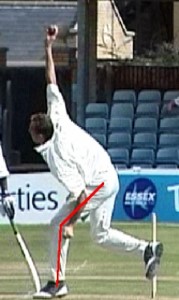
Figure 10
The technique displayed in Figure 10 is very inefficient, plus the bowler has lost a tremendous amount of height. All the bowler’s momentum is absorbed by the front leg, instead of bowling up and over a braced front leg. Though it is theoretically not ideal, many successful fast bowlers have used and continue to use this bent-leg technique. E.g. Lillee, Andy Roberts, Wasim Akram, etc. The author would like to highlight what would have happened if they were able to bowl with a braced front knee angle during the point of release?
On many occasions the angle of the front knee angle reduces even further after the ball was released. See Video 4. This means that the front leg is continually getting lower and lower, the momentum and energy of the bowler is being absorbed and wasted rather than transferred into the bowling arm.
After Ball Release the front leg collapses… This has the same effect of bowling in sand. If you were to throw a discus, javelin or even hit a golf ball, you would not do it with a collapsing front leg! The fast bowler should have a bowling technique that enables him / her to flex slightly at FFC, absorbing the high peak GRF’s, followed by an increase the front knee angle or at worst maintain the front knee angle during the release of the cricket ball.
6) Excessive Lateral Flexion (Bending sideways creates injury!) (57%)
The majority of the sixty bowlers analysed, exhibited an excessive lateral flexion of the torso at release. The main reason for bowlers falling away and creating unnecessary forces through their lower back was due to the upper body being out off alignment with the lower body. Incorrect hip and shoulder alignment, along with incorrect foot and stride alignment can cause this. One way to look for a potential problem is to draw a line through the shoulders at the moment of release and measure the angle created with the vertical. A number of bowlers exhibited angles of 70-80 (see figure 11b). It is preferable to have an angle much closer to the horizontal: approximately 45 as in Figure 11a Alan Donald.
It is very important to note by how much the shoulder angle to the vertical changes from FFC to RELEASE. It is also important to measure the angle of the pelvis to the vertical (hip joint at the moment of release) as well as the difference between these two angles. These angles are measured from the Back View (Figure 11a and 11b). The greater this angle than the more stress is place on the lower back, even if the hip-to-shoulder angle is low. Strength in the lumbar region is vital in order to prevent injuries in this area. It is also important to note the position of the head in both images; every effort must be made with bowlers to keep the head more upright throughout the delivery phase. In order to try and minimise these forces it is a good practical principal to try and get the bowler to release the ball directly above their front foot. Figure 10a shows the ball being released directly over the front foot. Figure 11b however shows that at the point of release the ball is outside the front foot (see vertical yellow line). The red line indicates the amount of lateral flexion is occurring in the spine.
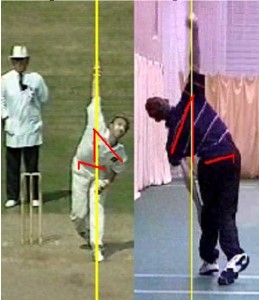
Figures 11a and 11b
Figure 11b highlights the excessive lateral flexion in a young fast bowler. Just prior to FFC the head is just starting to fall away to the left. At FFC the head and torso are leaning a long way to the left. This highlights what the spine has to cope with during the fast-medium bowling action. Finally at Ball Release the ball is a long way outside the line of the front foot.
All coaches should be fully familiar with the phrases Side-on, Front-on, Midway and Mixed Techniques. The hip-to-shoulder separation angle is used for the classification of MIXED ACTIONS. It is preferable to view bowlers at both BFC and FFC for hip-to-shoulder separation angles in order to obtain a more detailed analysis of the bowling action. However, it is during FFC that the loading and hence the forces through the body are at their maximum (5-10 BW).
Figure 12 highlights even though the hip-to-shoulder separation angle may be very small, there can still be a large degree of lateral flexion in the spine. Excessive lateral flexion has also been found in all types of bowlers including the mixed action bowler.
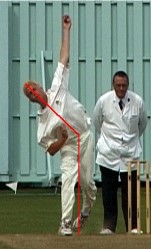
Figure 12
57% of the bowlers analysed, in the opinion of the author, had a sufficient lateral flexion to create potential injury problems. Excessive lateral flexion >60º will, over time, create problems around the lumbar region (lower back) along with rib injuries. Physical conditioning of this area is vital for the fast bowler.
7) General Alignment (Maintain momentum in one direction! – Pre-Delivery, Back Foot Contact, Front Foot Contact, First Stride in the Follow Through – 83%)
Very few bowlers of the sixty analysed demonstrated good alignment through the crease. In an ideal technique the pre-delivery stride, BFC, FFC and the first stride in the follow through should be in a straight line, AIMING TOWARDS THE TARGET. This should maximise the efficiency of the action; the top half and lower halves of the body will not be fighting each other. It is a simple procedure for all coaches to check and they should do so on a regular basis. Bowlers are allowed an angled run-up, that is fine, however the four steps Pre-Delivery, Back Foot Contact, Front Foot Contact, First Stride in the Follow Through MUST be all on the line of the intended target.
Figure 13 shows is a six-image sequence of a bowler jumping outwards towards 2nd slip during the pre-delivery take off, BFC and FFC. The red line follows the path of the feet during the action. The black arrow shows the target line. The two are totally different. Every effort should be made to get the run-up on a straight line and thus allow good alignment to happen naturally. The pre-delivery stride, BFC, FFC and the first stride in the follow through should be in a straight line, AIMING TOWARDS THE TARGET – follow the black arrow not the red line!
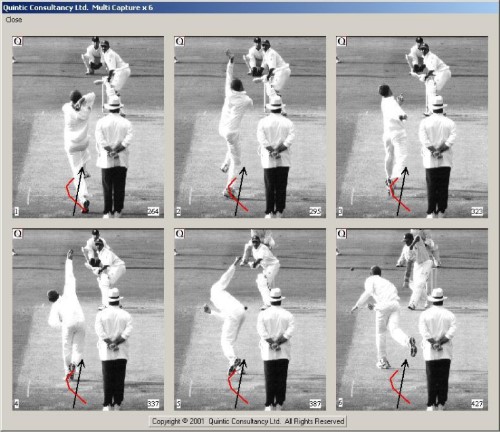
Figure 13
Just at the moment of Pre-delivery take off, notice how close the bowler is close to the stumps. However on BFC the bowler has jumped across to the middle of the crease. At FFC the bowler is even wider on the crease (Frame 68). All the bowler’s momentum is going towards 3rd slip! (RH Batsmen).
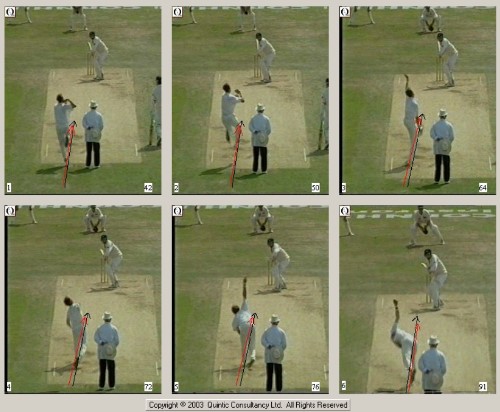
Figure 14
Figure 14 highlights Alan Donald demonstrating good alignment during the bowling action. The same red and black lines are used to highlight the differences between figure 13 and Figure 14. The bowler must maintain their momentum towards the batsman until first foot follow through has landed (Right Foot in the case of a right handed bowler) – then ensure that the next step is away from the danger area.
Figure 14 highlights Alan Donald demonstrating good alignment during the bowling action. The same red and black lines are used to highlight the differences between figure 13 and Figure 14. The bowler must maintain their momentum towards the batsman until first foot follow through has landed (Right Foot in the case of a right handed bowler) – then ensure that the next step is away from the danger area.
Limitations of the Study
The fast bowlers were analysed in competitative ECB age group cricket from three separate deliveries to represent their technique (Front / Back / Side views). In each case, ever effort was made to choose a ‘good length ball’ for analysis purposes. There is however, the possibility for technique variations within the same bowler (fatigue for example…), which may or may not influence injury incidence or performance factors. Burnett et al., 1995 has already highlighted how technique chnages as a result of a 12 over bowling spell. This is still an area for future research and development, Portus et al., 2000.
Conclusion
This study investigated the bowling action of sixty fast-medium bowlers playing England age groups U13, U14, U15, U17 and U19. The most common biomechanical and technical faults were identified. This data was used to develop a technical model of sports biomechanics and analysis for all fast-medium bowlers.
This study highlighted seven key biomechanical problems still found in the young fast medium bowler. Each bowler has an optimal position at where they should release the cricket ball. There are exceptions to the rule, there is a slight danger that future bowlers will be cloned to bowl in one particular way based on biomechanical models, however any biomechanist will agree that there is an optimal position for each individual, given strength and conditioning, flexibility, anthropometric data for that individual to bowl at optimal.
Qualitative analysis is very useful, but has to be used carefully when looking for similarities as well as differences in fast bowling technique.
The fast bowler’s technique places an creates incredible amount of stresses and strains on their body. The authors would suggest that if the seven most common technical faults can be eradicated then the young fast-medium bowler would greatly reduce the risk of injury and fully maximise their potential.
Acknowledgments
The author would like to acknowledge and thank the assistance and contribution of the English and Wales Cricket Board, the National Coaches of the English and Wales Cricket Board, The Science and Medicine Advisory Group (ECB) and Mr. John Harmer (Former Women’s Coach ECB).
References
Bartlett, R.M., Stockill, N.P., Elliott, B.C. and Burnett, A.F. (1996). The biomechanics of fast bowling in men’s cricket: A review. Journal of Sports Sciences, 14, 403- 424.
Burnett, A.F. and Elliott B.C. and Marshall R.N. (1995) the effect of a 12-over spell on fast bowling technique. Journal of Sports Sciences, 13, 329- 341.
Burnett, A.F.. Barrett, C., Marshall, R., Elliott B.C. and Day, R. (1998). Three-dimensional measuremnet of lumbar spine kinematics for fast bowlers in cricket. Clinical Biomechanics, 13, 574-583.
Burden, A. and Bartlett, R. (1990). A kinematic investigation of elite fast and fast medium cricket bowlers. In Proceedings of the VIIIth International Symposium of the Society of Biomechanics in Sports (edited by M. Nosek, D. Sojka, W. Morrisson and P. Susanka), pp. 41-46. Prague: Consport.
ECB. (2000). England and Wales Cricket Board – Cricket Coaches Manual. National Cricket Coach Initiative.
Elliott, B., Hardcastle, P., Burnett, A. and Foster, D. (1992). The influence of fast bowling and physical factors on radiological features in high performance young fast bowlers. Sports Medicine, Training and Rehabilitation, 3, 113-130.
Foster, D., John D., Elliott, B., Ackland T. and Fitch, K. (1989). Back injuries to fast bowlers in cricket: a prospective study. British Journal of Sports Medicine, 23(3), 150-154.
Hurrion, P.D. (1997) The effect of Neoprene Athletic Supports on Cricket Bowling and Javelin Throwing. Ph.D Doctor of Philosphy, Chichester Institute of Higher Education, Unviersity of Southampton.
Hurrion, P.D., Dyson, R.J., and Hale, T. (2000). Simultaneous measurement of front and back foot ground reaction forces during the delivery stride of the fast-medium bowler. Journal of Sport Sciences, 2 (3), 86-95.
Mason, B., Weissensteiner, J. and Spence, P. (1989). Development of a model for fast bowling in cricket. Excel, 6(1), 2-12.
Portus, M., Sinclair, P., Burke, S., Moore, D. and Farhart, P. (2000). Cricket fast bowling performance and technique and the influence of selected physical factors during an 8-over spell. Journal of sports Sciences, 18, 999-1011.
Portus, M. Mason, B.R., Elliott, B.C., Pfitzner, M.C. and Done, R.P. (2004). Technique factors relating to ball release speed and trunk injuries in high performance cricket fast bowlers. Sports Biomechanics Jul; 3(2):263-84.
Dr Paul Hurrion
(Ph.D Sports Biomechanics)
ECB Level IV – Biomechanics Tutor
ICC Bowling Review Group – Biomechanics Advisor
